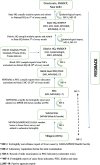An Evaluation of Malaria Surveillance System in Punjab, India, 2020
- PMID: 37469921
- PMCID: PMC10353677
- DOI: 10.4103/ijcm.ijcm_305_22
An Evaluation of Malaria Surveillance System in Punjab, India, 2020
Abstract
Background: India accounted for 6% of global burden of malaria with 95% population residing in malaria endemic areas. However, Punjab is in the malaria elimination phase with annual parasite incidence (API) <1/1000 population.
Objectives: We evaluated malaria surveillance system in Punjab using CDC's updated guidelines for evaluating public health surveillance systems to provide recommendations for strengthening the existing system and to overcome the challenges in the path of malaria free Punjab.
Methods: We chose two districts of Punjab, Amritsar (lowest API) and Mansa (highest API), interviewed stakeholders, and performed a retrospective desk review. We evaluated the overall usefulness of the system and assessed seven attributes at state, district, health facility, and village level during July-August 2020.
Results: In Punjab, there was progressive decline in the malaria cases from 2,955 cases in 2009 to 1,140 in 2019 and no malaria deaths since 2011. Regarding various attributes, overall score for flexibility was good (85.9%); average for simplicity (77%), acceptability (74%), data quality (74%), and timeliness (70%); and poor for representativeness (59%) and stability (57%).
Conclusions: Malaria surveillance system was useful in analyzing the trends of morbidity and mortality and for generating data to drive policy decisions. To improve stability, representativeness, and acceptability, surveillance staff should not be engaged in supplemental work, and reports from private sector must be ensured. Supportive supervision and regular trainings should be carried out regarding reporting formats, guidelines, and timely epidemiological investigations to improve timeliness, data quality, and simplicity.
Keywords: Evaluation; India; Punjab; malaria; surveillance.
Copyright: © 2023 Indian Journal of Community Medicine.
Conflict of interest statement
There are no conflicts of interest.
Figures
References
-
- World malaria report 2019. World Health Organization. [[Last accessed on 2020 Feb 26]]. Available from: https://www.who.int/news-room/feature-stories/detail/world-malariareport... .
-
- Micro Strategic Action Plan for Malaria Elimination in the State of Punjab, India. National Vector Borne Disease Control Programme. [[Last accessed on 2020 Sep 07]]. Available from: http://origin.searo.who.int/india/publications/strategic-action-planfor-... .
-
- National Vector Borne Disease Control Programme, Ministry of Health and Family Welfare, Government of India. Magnitude of the problem. [[Last accessed on 2020 Feb 26]]. Available from: https://nvbdcp.gov.in/inde× 4.php?lang=1 and level=0 and linkid=420 and ... .
-
- World Malaria Day 2019. National Health Portal of India. [[Last accessed on 2020 Aug 21]]. Available from: https://www.nhp.gov.in/world-malaria-day-2019_pg .
-
- National Framework for malaria elimination in India, 2016–2030. National Vector Borne Disease Control Programme, Ministry of Health and Family Welfare, Government of India. [[Last accessed 2020 Aug 22]]. Available from: https://nvbdcp.gov.in/WriteReadData/l892s/National-framework-for-malaria... .
LinkOut - more resources
Full Text Sources


